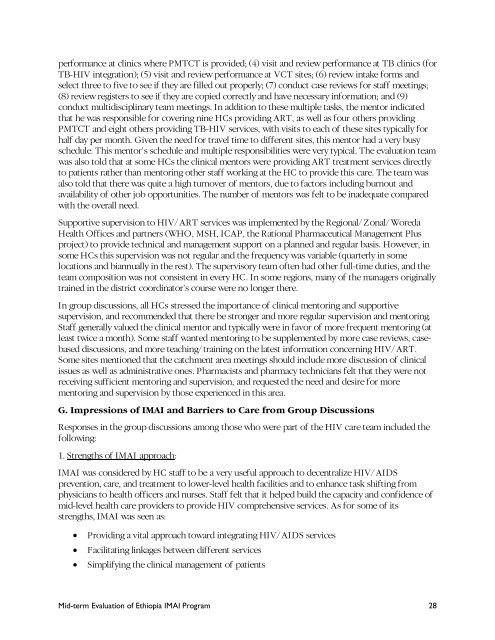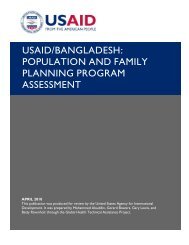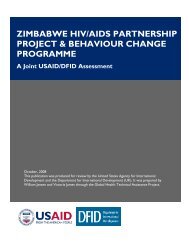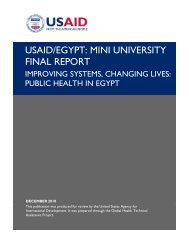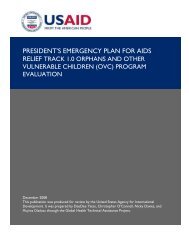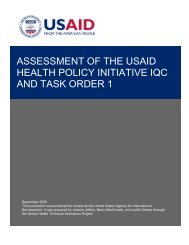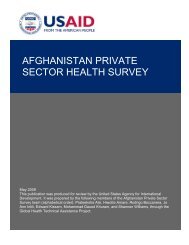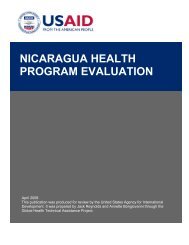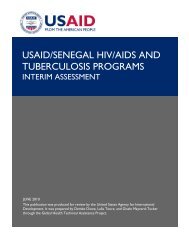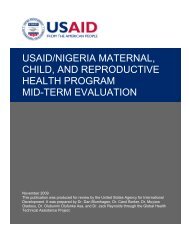usaid/ethiopia pepfar mid-term evaluation of the ... - GH Tech
usaid/ethiopia pepfar mid-term evaluation of the ... - GH Tech
usaid/ethiopia pepfar mid-term evaluation of the ... - GH Tech
- No tags were found...
You also want an ePaper? Increase the reach of your titles
YUMPU automatically turns print PDFs into web optimized ePapers that Google loves.
performance at clinics where PMTCT is provided; (4) visit and review performance at TB clinics (forTB-HIV integration); (5) visit and review performance at VCT sites; (6) review intake forms andselect three to five to see if <strong>the</strong>y are filled out properly; (7) conduct case reviews for staff meetings;(8) review registers to see if <strong>the</strong>y are copied correctly and have necessary information; and (9)conduct multidisciplinary team meetings. In addition to <strong>the</strong>se multiple tasks, <strong>the</strong> mentor indicatedthat he was responsible for covering nine HCs providing ART, as well as four o<strong>the</strong>rs providingPMTCT and eight o<strong>the</strong>rs providing TB-HIV services, with visits to each <strong>of</strong> <strong>the</strong>se sites typically forhalf day per month. Given <strong>the</strong> need for travel time to different sites, this mentor had a very busyschedule. This mentor’s schedule and multiple responsibilities were very typical. The <strong>evaluation</strong> teamwas also told that at some HCs <strong>the</strong> clinical mentors were providing ART treatment services directlyto patients ra<strong>the</strong>r than mentoring o<strong>the</strong>r staff working at <strong>the</strong> HC to provide this care. The team wasalso told that <strong>the</strong>re was quite a high turnover <strong>of</strong> mentors, due to factors including burnout andavailability <strong>of</strong> o<strong>the</strong>r job opportunities. The number <strong>of</strong> mentors was felt to be inadequate comparedwith <strong>the</strong> overall need.Supportive supervision to HIV/ ART services was implemented by <strong>the</strong> Regional/ Zonal/ WoredaHealth Offices and partners (WHO, MSH, ICAP, <strong>the</strong> Rational Pharmaceutical Management Plusproject) to provide technical and management support on a planned and regular basis. However, insome HCs this supervision was not regular and <strong>the</strong> frequency was variable (quarterly in somelocations and biannually in <strong>the</strong> rest). The supervisory team <strong>of</strong>ten had o<strong>the</strong>r full-time duties, and <strong>the</strong>team composition was not consistent in every HC. In some regions, many <strong>of</strong> <strong>the</strong> managers originallytrained in <strong>the</strong> district coordinator’s course were no longer <strong>the</strong>re.In group discussions, all HCs stressed <strong>the</strong> importance <strong>of</strong> clinical mentoring and supportivesupervision, and recommended that <strong>the</strong>re be stronger and more regular supervision and mentoring.Staff generally valued <strong>the</strong> clinical mentor and typically were in favor <strong>of</strong> more frequent mentoring (atleast twice a month). Some staff wanted mentoring to be supplemented by more case reviews, casebaseddiscussions, and more teaching/training on <strong>the</strong> latest information concerning HIV/ ART.Some sites mentioned that <strong>the</strong> catchment area meetings should include more discussion <strong>of</strong> clinicalissues as well as administrative ones. Pharmacists and pharmacy technicians felt that <strong>the</strong>y were notreceiving sufficient mentoring and supervision, and requested <strong>the</strong> need and desire for morementoring and supervision by those experienced in this area.G. Impressions <strong>of</strong> IMAI and Barriers to Care from Group DiscussionsResponses in <strong>the</strong> group discussions among those who were part <strong>of</strong> <strong>the</strong> HIV care team included <strong>the</strong>following:1. Strengths <strong>of</strong> IMAI approach:IMAI was considered by HC staff to be a very useful approach to decentralize HIV/ AIDSprevention, care, and treatment to lower-level health facilities and to enhance task shifting fromphysicians to health <strong>of</strong>ficers and nurses. Staff felt that it helped build <strong>the</strong> capacity and confidence <strong>of</strong><strong>mid</strong>-level health care providers to provide HIV comprehensive services. As for some <strong>of</strong> itsstrengths, IMAI was seen as:• Providing a vital approach toward integrating HIV/ AIDS services• Facilitating linkages between different services• Simplifying <strong>the</strong> clinical management <strong>of</strong> patientsMid-<strong>term</strong> Evaluation <strong>of</strong> Ethiopia IMAI Program 28


